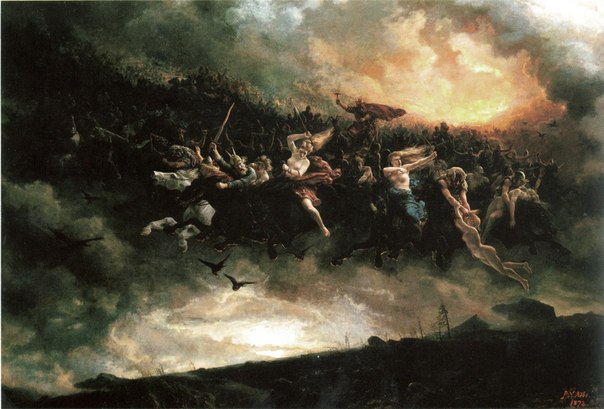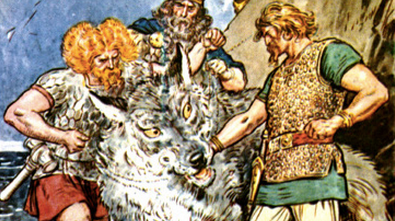
Thor — Giant-Slayer and God of Thunder — is the most well-known Norse god in our modern world. The Marvel comic books and films have of course spurred his fame, but they’ve also hampered our understanding of the Thor that Viking people worshiped and revered and looked to for protection. For one thing, rather than the flaxen-haired, neatly-groomed Marvel version, Thor was a red-haired, long-bearded half-giant. (I had to get the red-haired part in right from the get-go; as a fellow ginger, I’d be remiss not to call attention to this defining feature.)

Even though Odin carried the Allfather title, Thor was the most venerated god in the Norse pantheon. His hammer, Mjolnir, was a symbol of this reverence, and much like the Christian cross, Vikings would don it in the form of necklaces, bracelets, skin markings, etc. to remember the strength and hope of the mighty god. Even today, Thor remains a popular name for boys in Scandinavia.
In this article, we’ll look at how the God of Thunder earned the unmatched reverence of the Norse people, and what every man can learn from his mythology.
Who Was the Thunder God?

The eldest son of Odin (his mother was the giantess Jord), Thor had humble origins. We don’t know much about his beginnings, other than that he quickly overtook his father in popularity. Whereas Odin was mysterious and favored royals and leaders, Thor was protective of not only his friends and family, but common humans as well. His wife was Sif, a goddess whom we don’t know much about, other than her having a role in the creation of his famed hammer. Thor had three children, two boys and a girl, who survived Ragnarok — the Norse apocalypse — and went on to help recreate the world.
Thor’s most common foes were the giants who resided in Jotunheim — one of Norse mythology’s nine worlds. While sometimes cordial, the gods and giants got into frequent battles, with Thor almost always leading the charge and coming out on top. Riding in his goat-drawn chariot, his incessant fighting with the giants was perceived as thunder and lightning in Midgard (the world of the humans). When storms came, people knew that Thor was fighting on their behalf. This is why in Norse poems, he’s often referred to as the Thunder God.

Beyond the giants, Thor’s other primary enemy was Jormungand, the giant serpent who encircled Midgard. Having failed to kill him in multiple previous attempts, Thor finally succeeds during Ragnarok, only to fatally succumb to the monster himself.
Let’s take a look at some of Thor’s most enduring myths; thankfully, they’re more easily untangled than those of the complex Odin!
The Power of Power
Thor’s preeminent characteristic, like that of the Greek Hercules, was his strength. His power and prowess were unsurpassed in the Norse realm. He relied on his muscle and simple tools (more on those below) to overcome the fiercest of enemies. The gods of Asgard looked to Thor as a protector and defender; so too did the humans of Midgard, whose daily lives were disrupted and threatened by interloping giants. The wily figures of Odin and Loki (among other gods) didn’t give much hope to men; sure, they were clever and wise, but didn’t possess the strength or courage to go to battle with the ogres. Thor alone had the power and skill to fight the beasts and protect mankind.
There are countless stories of Thor engaging in epic battles with the giants and other creatures, almost always for the sake of protecting others. Let’s briefly look at a couple.
***
Odin was wandering around near Jotunheim, and encountered the giant Hrungnir. Odin challenged him to race their horses back to Asgard. While Sleipnir, Odin’s eight-legged stallion, was victorious, Hrungnir was still invited to stay for a feast. He got drunk and boastful, and joked about destroying Asgard and keeping their goddesses as concubine, including Sif, Thor’s wife.
Thor did not take this joking well, and challenged Hrungnir to a fight. The giant agreed, but it wouldn’t be then and there, as Hrungnir had no weapons on him; they’d instead meet near Jotunheim. In the meantime, the giants constructed a massive clay figure. Like, really massive: it was 30 miles high and 10 miles wide, and was brought to life for the purpose of being Hrungnir’s right-hand man. But when Thor saw Hrungnir and his new sidekick, he wasn’t fazed; instead, it was actually the clay giant who wet himself from fear.

Through some trickery of his own, Thor first sent a servant to occupy the clay giant, and then charged Hrungnir. At the Thunder God hurled Mjolnir towards his opponent, Hrungnir threw his own weapon — a giant whetstone. The hammer broke the giant’s weapon in half before continuing on and crushing Hrungnir’s head.
***
In another tale of Thor’s combative prowess, the ever-curious and up-to-trouble Loki was flying around in the form of a falcon when he was captured and imprisoned by a giant named Geirrod. The giant wouldn’t release Loki unless the trickster god could get Thor to come to the giant’s court. Thor agreed, and thinking it was a peaceful invitation, traveled without his trusty Mjolnir. Luckily, he made a pit-stop along the way at the home of a friendly giantess named Grid. She warned Thor that Geirrod actually planned on killing him, and loaned out her unbreakable staff.

When Thor arrived at Geirrod’s court, he was taken to a chamber and seated in the room’s only chair. The chair began invisibly rising towards the ceiling and Thor was on his way to being crushed to death. He pushed Grid’s staff against the roof and forced himself down with all his might until he heard two loud cracks, followed by agonizing screams. Thor looked down to see Geirrod’s two daughters writhing in pain; they were the ones lifting the chair upward, and he had cracked their backs while pushing himself back down.
An enraged Geirrod stormed into the chamber and threw a molten iron rod at Thor. When the god easily caught it, the giant fearfully hid behind a pillar for cover. Thor then threw the molten rod towards Geirrod, easily piercing the pillar, as well as the giant himself. The Thunder God was once again victorious.
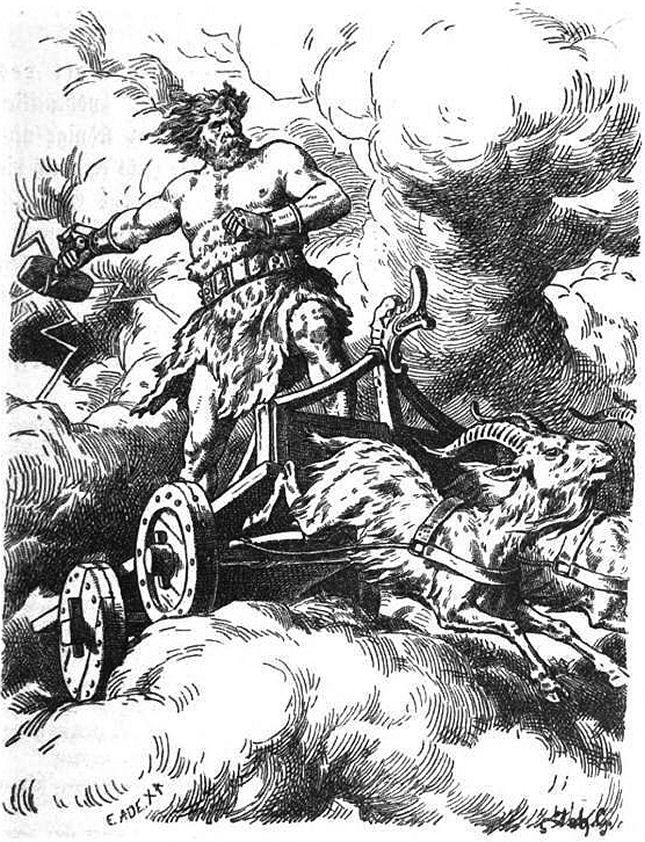
Stories like these abound in Norse mythology; for the sake of brevity I shared just these two characteristic examples. If you’d like to read more, Padraic Colum has a few fantastic collections of Norse tales.
The myths about the Thunder God tend to share the common themes of either defending someone’s honor, or helping someone in trouble. When the sh*t hits the fan, Thor is the one that both the gods and humans turn to defend their safety. Because he provides that basic necessity which overrides nearly all others, and because nothing else — no higher culture or refined virtue — is possible without first “securing the perimeter,” Thor was looked upon and revered more than the other gods. His physical strength put him into a place of leadership and power, even among the other Norse deities. In many ways, his strength made possible the rest of the Viking universe.
Today, strongmen are typically just sideshows who break records and participate in competitions on TV. Our culture has shifted to valuing mental strength over physical strength, and bulging muscles have come to be seen as more characteristic of self-indulgent bros than well-rounded, virtuous men.
This is a shame, as physical strength can actually serve as the lynchpin for all other virtue. As Brett has written, “[physical strength] provides the necessary backbone — the proper framework — on which to build our moral values. The cloak of virtue hangs very awkwardly on a man without fire and fight; it droops and sags when draped across a structure that lacks strength and firmness.” Even Socrates — the patron saint of philosophy and intellectualism — viewed the cultivation of one’s physique as being just as important as building up one’s mental muscles. He said: “For in everything that men do the body is useful; and in all uses of the body it is of great importance to be in as high a state of physical efficiency as possible. Why, even in the process of thinking, in which the use of the body seems to be reduced to a minimum, it is matter of common knowledge that grave mistakes may often be traced to bad health.” The lessons of discipline and willpower that are imparted by building one’s muscles are not just physical in nature, but carry over into every other aspect of life.
Brett has written an excellent article about why every man should be strong, and Thor exemplifies that imperative better than any other mythological figure.
Thor’s Tools of the Trade
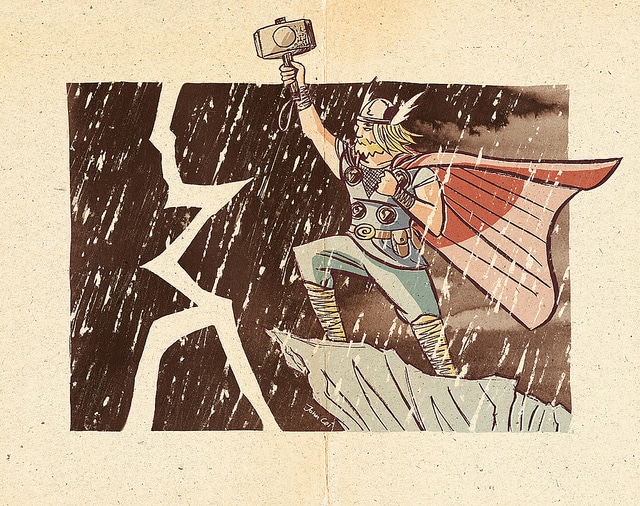
Beyond just his incredible strength, Thor is most associated with his trusty hammer — Mjolnir. It’s a tool imbued with magical powers and can only be hoisted by the god himself. Beyond his hammer, Thor also dons a magical belt (named Megingjoro) which doubles his strength, and iron gloves (named Járngreipr) that allow him to wield the mighty Mjolnir.
Let’s look at the myth which explains the origins of Thor’s signature tools (even though it’s more about Loki than Thor).
***
One day, Loki was feeling especially mischievous and decided to cut off the beautiful, golden hair of Thor’s wife, Sif. Thor was obviously quite angry at this, and swore he’d break every bone in Loki’s body to defend his wife’s honor. The trickster, however, pleaded with Thor to let him go down to the cavernous home of the dwarves and see if those master craftsmen could fashion new and better hair for Sif.
So Loki ventured to the home of the dwarves, where Ivaldi’s sons indeed made new hair for Sif (made of fine strands of gold), as well as two other gifts — a ship that always had a favorable wind and could be folded into one’s pocket, and a marvelous, deadly spear.

Loki enjoyed being down in the caves and wanted to stay and have some more “fun” with the dwarves. So he made a wager (betting his own head!) with two brothers that they couldn’t fashion three gifts for the gods which would best the three offerings made by Ivaldi’s sons. While the dwarves were forging new gifts, Loki shapeshifted into a fly, and stung the brothers over and over in an attempt to interrupt their precious work and win the bet. While fashioning the final gift — a ferocious hammer — Loki managed to sting the brothers badly enough to partially interrupt their vision, and the hammer ended up with a short handle. Nevertheless, even in its imperfection, the hammer was deemed the best of all the gifts, and given to Thor, as he was the only god worthy of carrying it into battle. Of course, through some clever trickery, Loki didn’t lose his head, but that’s a tale for another day.
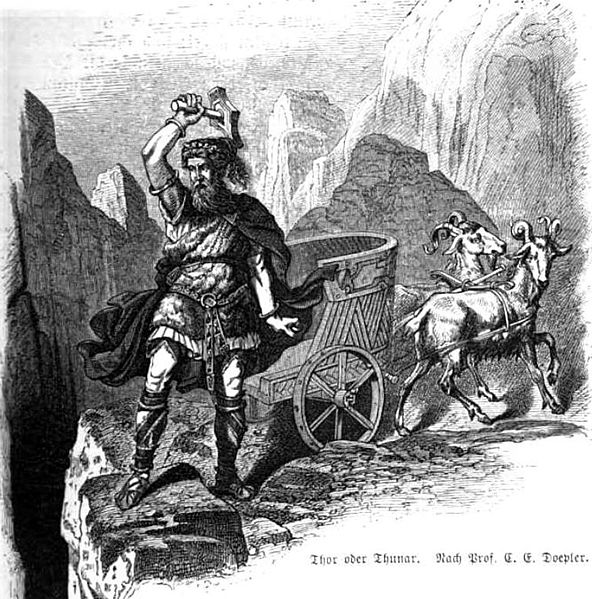
When Thor was presented with Mjolnir, it’s not a reach to assume he had to learn its proper use and form before truly getting the most out of it. For instance, the hammer had magical powers which allowed it to fly back to Thor, like a boomerang, whenever he threw it. Given that he’s not a perfect god — nor are any in Norse mythology — it’s easy to picture him hanging out in his backyard just tossing the hammer and learning its movements so he could deftly catch it and fling it once again into oncoming enemies.
Without this kind of pursuit of mastery, our tools are worthless. The more you practice and train, the more they become second nature, and less brain power is needed to operate them. When properly mastered, our tools can even enhance our courage in the heat of battle. Imagine the confidence Thor possessed while battling giants with Mjolnir in his hand; he knew the hammer’s every idiosyncrasy, and understood that it wouldn’t fail him if he used it properly and strategically.
While tools of the trade are important for any man, don’t be tricked into thinking that a certain tool or weapon can make or break you. We tend to think that if we had the right techno gadget, we’d be more productive; if we had a nicer-looking journal we’d write in it more, and therefore be more reflective; if we only had the perfect home gym we’d work out more and lose that extra flab. The reality is that even when we get these seemingly perfect tools, our life stays more or less the same. What truly accelerates virtue and progress in a man’s life is action — including mastering the tools in front of us — rather than simply having the perfect equipment.
Ultimately, while tools are necessary and can aid and enhance our courage and effectiveness, a man must be willing to take action with imperfect tools. Thor’s hammer wasn’t a perfect creation, and yet he used his strength to overcome that flaw, and bested his foes at nearly every turn. But, as we’ll see next, not even Thor could beat every enemy.
Even Gods Fail
In any collection of tales about the Norse gods, one of the first you learn of is not Thor’s conquering of a great beast, or the slaying of an enemy-warrior, but his defeat at the hands of the giant-king Utgard-loki.
***
One particular winter, the giants were being especially mischievous by causing gigantic blocks of ice to fall from the sky onto men’s homes, as well as directing enormous amounts of snow to cover the farmers’ fields. Thor, as the guardian of humanity, was incensed. So he ventured into Jotenheim, the world of the giants, with Loki and two other companions.
As they were traveling, they stopped in an oddly-shaped, empty house to spend the night. Upon returning to the trail in the morning, they discovered that a nearby hill was in fact a prostrate giant, and the house they slept in was in fact his glove. This giant awoke, introduced himself as Skrymir, and offered to guide them on their journey.
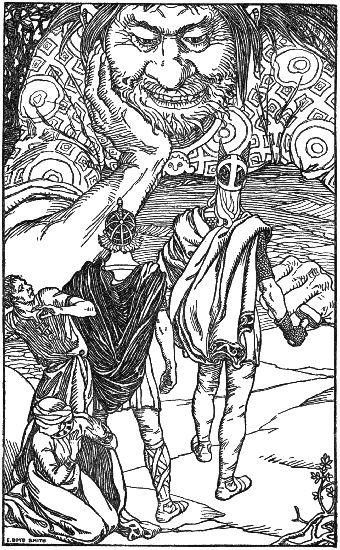
They traveled all day, with the gods struggling to keep up with the bounding giant. After a fretful night in which Skrymir’s snoring — as strong as earthquakes — kept them awake, they continued on to Jotunheim. This time, the giant roared ahead and left the gods and their companions behind. Thankfully, the beast’s immense size left a clear trail, and they found their way to a great palace, which they entered by slipping through the bars of an enormous gate.
Upon arriving, they were greeted by a band of giants, including the king, Utgard-loki. Thor, Loki, and their companions were not welcome, however, unless they completed a series of arduous tasks. Loki engaged in a meat-eating contest, but lost when his opponent ate not just the meat, but the bones and even the platter. Thialfi, one of the gods’ companions, lost three consecutive footraces. It was now Thor’s turn, and he took part in three contests.
Thor said he could drink a great deal, so was brought a large horn which he was challenged to drain in a single gulp. After three enormous swallows, however, he hadn’t managed to imbibe more than a few inches. Thor then boasted of his strength, and King Utgard-loki challenged the god to simply lift a gray cat off the ground. After three attempts, Thor inexplicably found he could only raise a single of its paws. Finally, the enraged Thor welcomed a wrestling match with anyone who would accept. Surprisingly, it was a frail old woman who came forth. Yet Thor met with failure again; though he tried with all his might, he mystifyingly could not even defeat his geriatric opponent, who handily brought him to his knees.
After this, Utgard-loki declared that the contests would be over, and in spite of the gods’ failure, they could stay the night and feast.
The next morning, Utgard-loki led the traveling company out of his land. Once past the boundary, he declared himself to be one and the same as the giant Skrymir, and revealed he had known their godly status the whole time. He then also disclosed the tricks he had played on them: Loki’s competition was in fact wildfire, which consumes everything it touches. Thialfi’s opponent was thought, which cannot be outrun. Thor then learned that the tip of the horn he drank from was connected to the ocean; he had in fact lowered sea levels. The cat he tried to raise was none other than the world-encircling Midgard serpent. And the old woman? Age itself. Thor had fought bravely, but even the mightiest invariably fall to that cunning crone.
After learning all this, Thor raised his hammer to strike down the giant-king, only to find that he and his entire palace had disappeared, leaving only a vast plain.
***
You see, even gods have limitations. The greatest of men cannot defeat the forces of nature — be it natural calamities or the onslaught of disease and old age. Hubris is one of man’s greatest foes; humility one of his greatest allies. Rather than becoming enraged at “failure” over these elements, it’s best for a man to understand that not everything is in his control. When realizing that there are greater forces at work in this world, he is actually free to take charge of what he can control, and simply do the best with the cards that life has dealt.
Additionally, Thor used his defeat at the hands of Utgard-loki as a moral reminder to spur him to greater deeds in the future. As author Graeme Davis noted, “He never forgot the humiliation…and he promised himself a reckoning against the giants.” Thor had a manly sense of honor and used the shame he felt to channel his fire and fight into his continued defense of both gods and humans. Instead of wilting away, he only grew stronger from his failure.
Thor: The Ultimate Example of Manliness
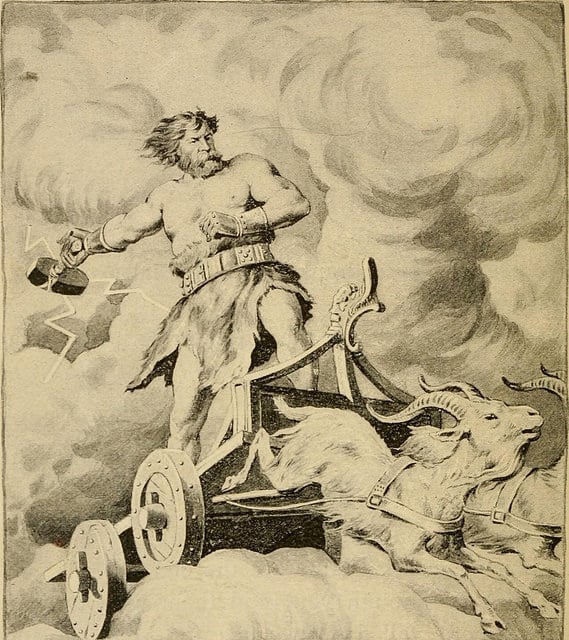
When looking at the three pillars of manhood — Protect, Provide, Procreate — Thor arguably embodies them all more than almost any other god in any culture’s mythology. Though he’s not the pinnacle of “goodness,” he’s the ultimate example of being good at being a man (or a god, that is). Thor uses his strength to defend his own honor, as well as that of his friends, family, and loved ones; he’s the ultimate defender of the perimeter. His tools help him provide for his family, but he knows how to improvise should he need to. And even though we don’t know many details about his family, he does indeed procreate and helps raise up the next generation of world-creators.
While Odin represented the cultivation of the mind and the attainment of wisdom, Thor represents the cultivation of the body. Physical strength is just as important as mental strength; just because it’s not as needed in our current climate doesn’t make it a less worthy pursuit. In the Viking age, those men who deftly combined the characteristics of Thor with those of Odin (as well as other gods) were the most revered and fulfilled. They could recite poetry and engage in “battles” of words and rhymes (yes, the Vikings had rap battles), but could also maneuver a hefty battle axe and willingly sacrifice themselves for their family and community. May we emulate those Viking men of old, and seek to better not just our minds, but our bodies as well, using Thor as our compass.
Read the Series:
______________
Sources and Further Reading
Gods and Myths of Northern Europe by H.R. Ellis Davidson. This textbook from 1965 is a surprisingly readable guide to not only Norse myths, but their context and symbolism within the Viking culture.
The Age of the Vikings by Anders Winroth. This is a history of the Viking people, rather than a specific look at Norse mythology. It helps set the stage, however, and does well in giving an honest account of their culture.
The Poetic Edda (Hollander translation). A collection of anonymous mythical poetry and verse from the 1300s that serves as an origin text for many Norse myths.
The Prose Edda by Snorri Sturluson. A textbook-like work from the Icelandic historian which compiles Norse myths. This, along with The Poetic Edda, offer the majority of source material for Norse mythology.
Nordic Gods and Heroes by Padraic Colum. This is a collection of reimagined and rewritten Norse myths. They’re in a language that captures the beauty and inspirational nature of the tales rather than a rote translation of ancient words.
Norse Mythology for Smart People. An online treasure trove of articles and information about the mythological Norse universe.


